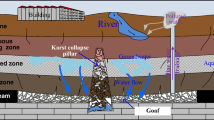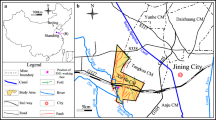Abstract
Mining-induced groundwater inrush, a type of serious hazard for underground coal extraction, occurs in tunnel or coal face combined with a large volume of groundwater gushing. It has an impartible relationship with geological structures such as karst collapse pillar (KCP), which is widely distributed in North China. To analyze the effect of coal mining on groundwater inrush caused by seepage instability of the penetrated KCP (PKCP), stress and seepage coupling equations are used to model the seepage rule, and a numerical FLAC3D model is conducted to determine the shear stress, damage zone, pore pressure, seepage vectors and effect of damage zone on seepage field development. The results indicate that when PKCP and the surrounding rocks show dislocation, shear failure may occur, which leads to a shear sidewall channel for groundwater inrush. As mining advances, the damage zone in the PKCP and its crushed area develop gradually, and the simulated damage zone development was consistent with observed thicknesses of crushed rocks. Under the effect of the support pressure and unloading of the coal face, an obvious seepage concentrate channel with greater hydraulic head and seepage vectors will form within the edge of the PKCP; then, the shear sidewall channel will gradually move to the other side with the coal face near and away. When the damage zones are crushed through, the connected fractures will become a strong seepage channel in PKCP, named as pipe flow, which may cause groundwater inrush.













Similar content being viewed by others
References
Bai HB, Ma D, Chen ZQ (2013) Mechanical behavior of groundwater seepage in karst collapse pillars. Eng Geol 164:101–106
Chen SP (1993) Formation of karst collapse pillar in Fengfeng area in Hebei. Carsologica Sin 12(3):233–244
Cheng YM, Wang JA, Xie GX, Wei WB (2010) Three-dimensional analysis of coal barrier pillars in tailgate area adjacent to the fully mechanized top caving mining face. Int J Rock Mech Min Sci 47:1372–1383
Fama MED, Trueman R, Craig MS (1995) Two- and three dimensional elasto-plastic analysis for coal pillar design and its application to high wall mining. Int J Rock Mech Min Sci 32:215–225
He KQ, Guo D, Du W, Wang R (2007) The effects of karst collapse on the environments in North China. Environ Geol 52(3):449–455
He KQ, Yu GM, Lu YR (2009) Palaeo-karst collapse pillars in northern China and their damage to the geological environments. Environ Geol 58(5):1029–1040
He KQ, Zhang SQ, Wang F (2010) The karst collapses induced by environmental changes of the groundwater and their distribution rules in China. Environ Earth Sci 10:1075–1084
Hoek E (1990) Estimating Mohr–Coulomb friction and cohesion values from the Hoek–Brown failure criterion. Int J Rock Mech Min Sci 27:227–229
Hu XY, Wang LG, Lu YL, Yu M (2014) Analysis of insidious fault activation and water inrush from the mining floor. Int J Min Sci Technol 24(4):477–483
Itasca Consulting Group Inc. (2009) FLAC3D (Fast Lagrangian Analysis of Continua in 3 Dimensions), version 4.0. Minneapolis
Jiang YD, Wang HW, Xue S, Zhao YX, Zhu J, Pang XF (2012) Assessment and mitigation of coal bump risk during extraction of an island longwall panel. Int J Coal Geol 95(1):20–33
Kang Y (1992) A discussion of karst collapse formulation patterns. Hydrogeol Eng Geol 19(4):32–33 (in Chinese and abstract in English)
Li GY, Zhou WF (2006) Impact of karst water on coal mining in North China. Environ Geol 49:449–457
Lokhande RD, Murthy VMSR, Singh KB (2013) Pot-hole subsidence in underground coal mining: some Indian experiences. Geotech Geol Eng 31(2):793–799
Lu HF, Yao DX, Shen D, Cao JY (2015) Fracture mechanics solution of confined water progressive intrusion height of mining fracture floor. Int J Min Sci Technol 25(1):99–106
Ma D, Bai HB (2015) Groundwater inflow prediction model of karst collapse pillar: a case study for mining-induced groundwater inrush risk. Nat Hazards 76(2):1319–1334
Ma D, Mao XB, Li C, Du F (2012) Boundary integral computation of elastic water resisting key strata under the condition of discontinuous load. CMES 83(6):561–574
Ma D, Miao XX, Chen ZQ, Mao XB (2013) Experimental investigation of seepage properties of fractured rocks under different confining pressures. Rock Mech Rock Eng 46:1135–1144
Ma D, Miao XX, Jiang GH, Bai HB, Chen ZQ (2014) An experimental investigation of permeability measurement of water flow in crushed rocks. Transp Porous Media 105:571–595
Ma D, Bai HB, Chen ZQ, Pu H (2015a) Effect of particle mixture on seepage properties of crushed mudstones. Transp Porous Media 108(2):257–277
Ma D, Miao XX, Chen ZQ, Mao XB (2015b) Erratum to: Experimental investigation of seepage properties of fractured rocks under different confining pressures. Rock Mech Rock Eng 48:2183
Ma D, Bai HB, Miao XX, Pu H, Jiang BY, Chen ZQ (2016) Compaction and seepage properties of crushed limestone particle mixture: an experimental investigation for Ordovician karst collapse pillar groundwater inrush. Environ Earth Sci 75:11
Miao XX, Cui XM, Wang JA, Xu JL (2011a) The height of fractured water-conducting zone in undermined rock strata. Eng Geol 120:32–39
Miao XX, Li SC, Chen ZQ, Liu WQ (2011b) Experimental study of seepage properties of broken sandstone under different porosities. Transp Porous Media 86:805–814
Pietruszczak S, Mro Z (1980) Numerical analysis of elastic-plastic compression of pillars accounting for material hardening and softening. Int J Rock Mech Min Sci 17:199–207
Qian XP (1988) The formation of gypsum karst collapse pillars and hydrogeologic implications. Carsologica Sin 7(4):344–346 (in Chinese and abstract in English)
Rong HR, Bai HB (2014) Pore structure characteristics of the relative water-resisting layer on the top of the Ordovician in Longgu coal mine. Int J Min Sci Technol 24(5):657–661
Rutqvist J, Tsang CF (2002) A study of caprock hydromechanical changes associated with CO2-injection into a brine formation. Environ Geol 42:296–305
Sheng JC, Liu J, Zhu WC, Elsworth D, Liu JX (2008) Stress analysis of a borehole in saturated rocks under in situ mechanical, hydrological and thermal interactions. Energy Sour A Recovery Util Environ Eff 30(2):157–169
Shi J, Lian D, Yang S (1998) A discussion of karst collapse. Geol Min Res North China Mag 13(3):264–266 (in Chinese and abstract in English)
Shi LQ, Qiu M, Wei WX, Xu DJ, Han J (2014) Water inrush evaluation of coal seam floor by integrating the water inrush coefficient and the information of water abundance. Int J Min Sci Technol 24(5):677–681
Singh RN (1986) Mine inundations. Int J Mine Water 5(2):1–28
Singh R, Sheorey PR, Singh DP (2002) Stability of the parting between coal pillar workings in level contiguous seams. Int J Rock Mech Min Sci 39(1):9–39
Tharp TM (1999) Mechanics of upward propagation of cover-collapse sinkholes. Eng Geol 52(1):23–33
Troitzky GM (1993) Sinkhole danger-engineering problem of covered karst, applied karst geology. Balkema, Rotterdam, pp 231–232
Vutukuri VS, Singh RN (1995) Mine inundation-case histories. Mine Water Environ 14:107–130
Wang R (1982) Cause of formation of karst collapse pillar in northern China. Hydrogeol Eng Geol 9(1):37–41
Wang HW, Jiang YD, Zhao YX, Zhu J, Liu S (2013) Numerical investigation of the dynamic mechanical state of a coal pillar during longwall mining panel extraction. Rock Mech Rock Eng 46(5):1211–1221
Wu Q, Xu H, Pang W (2008a) Advances and challenges of GIS and DBMS applications in karst. Environ Geol 54(5):937–943
Wu Q, Xu H, Pang W (2008b) GIS and ANN coupling model: an innovative approach to evaluate vulnerability of karst water inrush in coalmines of north China. Environ Geol 54:937–943
Wu Q, Xing LT, Ye CH, Liu YZ (2011) The influences of coal mining on the large karst springs in North China. Environ Earth Sci 64:1513–1523
Xeidakis GS, Torok A, Skias S, Kleb B (2004) Engineering geological problems associated with karst terrains: their investigation, monitoring, and mitigation and design of engineering structures on karst terrains. Bull Geol Soc Greece 36:1932–1941
Xu WG, Zhao GR (1988) Vacuum erosion caused karst collapse. Hydrogeol Eng Geol 16(1):2190–2194 (in Chinese)
Yao BH (2012) Research on variable mass fluid–solid coupling dynamic theory of crushed rock mass and application. China University of Mining and Technology, Xuzhou (in Chinese and abstract in English)
Yao BH, Wei JP, Wang DK, Ma D, Chen ZQ (2013) Numerical study of seepage property of karst collapse columns under particle migration. CMES 91(2):81–100
Yin SX, Zhang JC (2005) Impacts of karst paleo-sinkholes on mining and environment in northern China. Environ Geol 48:1077–1083
Yin SX, Zhang JC, Liu DM (2015) A study of mine water inrushes by measurements of in situ stress and rock failures. Nat Hazards 79(3):1961–1979
Yuan D (1994) Karstology of China. Geological Publishing House, Beijing (in Chinese)
Zhang JC (2005) Investigations of water inrushes from aquifers under coal seams. Int J Rock Mech Min Sci 42:350–360
Zhang JC, Peng SP (2005) Water inrush and environmental impact of shallow seam mining. Environ Geol 48:1068–1076
Zhang Y, Qu Y, Liu G, Lu P (2000) Some problems of karstic collapse pillars in North-China-type coalfields. J Eng Geol 1:35–39 (in Chinese and abstract in English)
Zhou Y, Rajapakse R, Graham J (1998) A coupled thermoporoelastic model with thermo-osmosis and thermal-filtration. Int J Solids Struct 35(34–35):4659–4683
Zhu WC, Wei CH (2011) Numerical simulation on mining-induced water inrushes related to geologic structures using a damage-based hydromechanical model. Environ Earth Sci 62:43–54
Acknowledgments
This work was supported by the Fundamental Research Funds for the Central Universities (2015XKZD06), the Innovative Research Group of the National Natural Science Foundation of China (51421003) and the National Natural Science Foundation of China (51574228 and 51504243). The authors would like to thank two anonymous referees for their careful reading of this article and valuable suggestions.
Author information
Authors and Affiliations
Corresponding authors
Rights and permissions
About this article
Cite this article
Ma, D., Miao, X., Bai, H. et al. Effect of mining on shear sidewall groundwater inrush hazard caused by seepage instability of the penetrated karst collapse pillar. Nat Hazards 82, 73–93 (2016). https://doi.org/10.1007/s11069-016-2180-9
Received:
Accepted:
Published:
Issue Date:
DOI: https://doi.org/10.1007/s11069-016-2180-9




